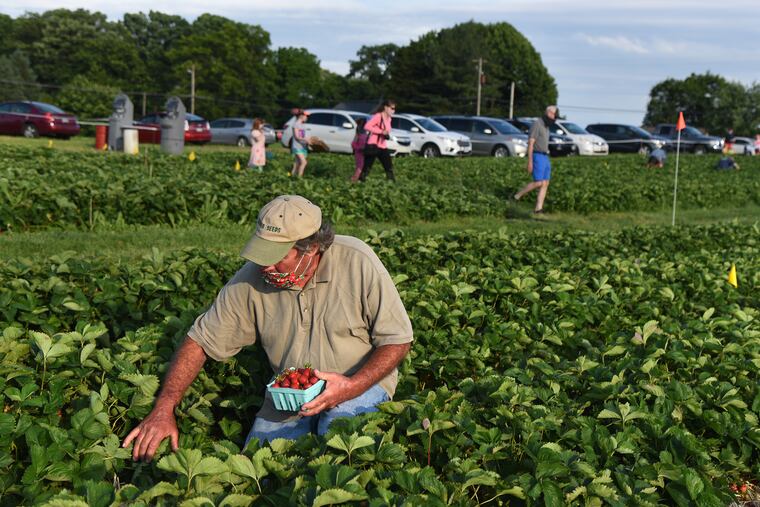Dryness in the Philly region is a growing concern, but it has perks for farmers — and for strawberry lovers
The lack of rain has a decided plus side for farmers, their crops, and consumers. Says one expert observer: Growers “are loving this dry weather.”

Hardly a drop of rain has fallen since May 9, and last week, more of the region entered the “abnormally dry” zone on the national drought map.
Caution flags notwithstanding, however, so far the dry run has produced decided silver linings for growers, and consumers of local fruits and vegetables are reaping the benefits, say the region’s agricultural specialists.
“Lack of rain has made for a great strawberry season,” said Michelle Infante-Casella, a professor with the Rutgers University Cooperative Extension of Gloucester County, where rainfall the last 30 days was just 42% of normal through Wednesday, according to the Middle Atlantic River Forecast Center.
Despite nature’s parsimony, thanks to adequate rains in the preceding months and generally seasonable temperatures, “There is plenty of moisture in the ground,” said Infante-Casella’s colleague, Hemant Gohil. And the region has been spared the spring freezes that ambushed crops last year.
» READ MORE: Where to pick your own strawberries, blueberries, raspberries, and blackberries near Philadelphia
The dryness, they both noted, is the enemy of fungal diseases, so that means less spraying and thus better crops and cost savings for the farmers. In fact, he said, the growers of peaches, apples, cherries, wine grapes, and ornamental crops “are loving this dry weather.”
Said Andrew Frankenfield, agricultural educator at the Penn State Extension in Montgomery County, “It has been ideal planting conditions and even hay-making weather.”
All that said, concerns are growing about clouds building on the horizon — or the lack thereof, and nature is about to turn up the heat, with temperatures in the mid-90s on Sunday.
Where we stand
Rainfall in the last 30 days ranged from 41% of normal in Camden County, to 52% in Chester County, based on calculations by the National Weather Service’s river forecast center, which averages measurements from several gauges within each county.
The trend has not escaped the attention of the interagency U.S. Drought Monitor. In its weekly update it included all of Chester County and most of Southeastern Pennsylvania west of Philly to the “abnormally dry” zone.
At this point, said Frankenfield, farmers could stand “a couple of rain days to replenish topsoil moisture.”
On the Jersey side, Infante-Casella said, “Field corn and soybeans are currently being planted, and lack of rainfall may slow seed germination. We could use some rain to help with that.”
Another issue in South Jersey is the sandy soil, Gohil said. “Now these growers need to irrigate more frequently,” he said. “Sandy soils have much less water-holding capacity than loamy soils.”
» READ MORE: Summer arrives in Philly; 90-plus temperatures possible Sunday
So far no drought advisories have been posted for South Jersey, and the “abnormally dry” designation to the west is a step below drought.
Actually, it has been quite awhile since we had anything remotely approaching a serious drought in the Philadelphia region.
We’re spoiled
According to data from the Pennsylvania Department of Environmental Protection, from 1980 to 2002, Philadelphia and all its four neighboring counties west of the Delaware River were in drought “warning” and/or “emergency” status on average once every three years.
That hasn’t been the case even once since 2002 as Philadelphia has experienced rainfall above long-term averages in 12 of the last 18 years, and all but two of the six others were within a splash of average.
Climate change is a prime suspect in that bounty, as warmer air can hold more moisture.
» READ MORE: ‘Normal’ temperatures reach new highs, and Philly snow totals are also up
Rain has been so plentiful in recent years that the National Centers for Environmental Information has increased the annual “normal” precipitation in Philadelphia by 6%, from 41.53 inches to 44.11.
In the short term, the extended outlook calls for gardeners to keep their hoses handy: No significant rain is in the forecast through the next week.
On the other hand, Las Vegas somehow gets by on 4 inches of precipitation a year.